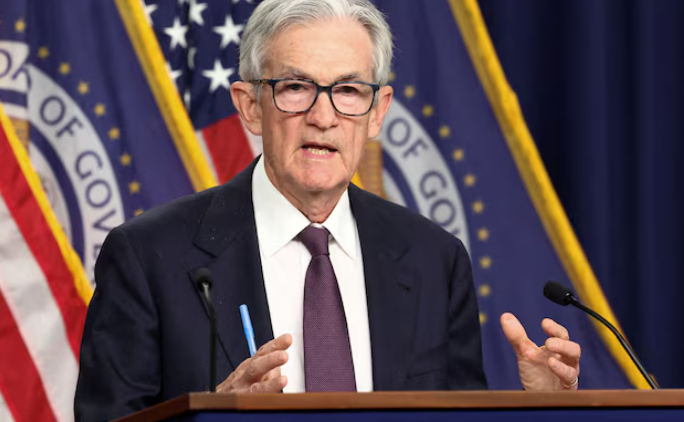The Federal open Market Committee stated its commitment to wait and see how the U.S. economy responds to economic policy in May. The reserve staff now view a recession as “almost as likely” as their baseline forecast, according to minutes from the banks May meeting. Policy makers are caught between a resilient labor market and growing signs of economic strain as President Donald Trump tariffs threaten slow growth and increased consumer prices. As such, the committee unanimously agreed to keep the target rate range for the Fed funds rate unchanged at 4.25 percent to 4.5 percent.
Fed officials cited the delay in capital investments by businesses, in response to trade uncertainty, as well as the decline in consumer sentiment, both weighing on demand. Our analysts at Sigmanomics are expecting economic data to miss expectations and/or be released subpar in the coming months with the recent trade effects to negatively impact the worlds largest economy. At the same time, we expect two to three quarter rate cuts in the second half of 2025.
Key Quotes
- “Participants agreed that uncertainty about the economic outlook had increased further, making it appropriate to take a cautious approach until the net economic effects of the array of changes to government policies become clearer,” the minutes said
- “Participants noted that the Committee might face difficult tradeoffs if inflation proves to be more persistent while the outlooks for growth and employment weaken.”
- “In considering the outlook for monetary policy, participants agreed that with economic growth and the labor market still solid and current monetary policy moderately restrictive, the Committee was well positioned to wait for more clarity on the outlooks for inflation and economic activity,” the summary said
- “uncertainty about the economic outlook has increased further.”
Analysts and Economists Expectations; Market Reaction
TD economics recently stated that “our expectation is that the momentum in the economy will start to peter out in the coming months as the cumulative effects of tariffs and uncertainty begin to prop up prices and weight on the labor market.” We also share the same sentiment as monetary policy will face a dilemma in balancing inflation against a deeper downturn with consumer and business sentiment tethering back.
SPX Weekly Chart

The market response exhibited a mixed character today. U.S. equities initially faced a sharp decline, driven by investor concerns over economic indicators, before making a recovery later in the trading session. Meanwhile, the U.S. dollar strengthened against other currencies, reflecting increased demand for safe-haven assets, while Treasury yields eased, suggesting a retreat from riskier investments.
In Europe, the landscape was marked by notable declines, with Germany’s DAX index registering the most significant drop, falling 0.78%. This decline was influenced by weaker-than-expected economic data. The U.K.’s FTSE 100 followed closely with a decrease of 0.59%, attributed to losses in key sectors such as energy and consumer goods. France’s CAC 40 also experienced a downturn, retreating by 0.49%, impacted by market volatility and broader economic concerns.
In Asia, the Hang Seng Index dipped slightly by 0.53%, reflecting investor caution amid ongoing geopolitical tensions and economic uncertainties. In contrast, the Nikkei Index in Japan remained flat, indicating a period of consolidation as investors weighed domestic economic signals against global trends.
Taking a look at the weekly SPX chart above, price action has retraced back to the 78.6 percent Fibonacci retracement on weekly chart without any clear break above this zone. With deepening RSI bearish divergence, bulls should trade with caution as a deeper move lower seems to be on the horizon. Keep support and resistance levels according to Sigmanomics pivot table is listed below. Aside from key pivot table, should short and medium term support begin to give, bears will look to eye 4704 area as it represents equal legs (100% ) of the fibonacci extension area. Also on the weekly chart, the 9 day moving average remains below the 21 day moving average, which favors downside risks; however, with a positive sloping short term moving average, bears should proceed with caution as a crossover is not ruled out.
Looking ahead, based off of CME futures data above, markets are pricing in a 95 basis points (bps) rate cut between June 2025 and the end of the year. Meanwhile the markets are also pricing in 52bps for 2026. Thus far, the first rate cute was pushed back to September. This is consistent with the idea that the Fed will shift from a restrictive stance to an accommodative policy as disinflationary pressures intensify.
Policymakers face several risks, including inflation, geopolitical disruptions, and employment conditions in the United States. If inflation proves to be more persistent than previously anticipated, the Federal Reserve may not ease monetary policy as quickly as the markets expect. Additionally, challenges in the labor market could further delay any easing, as a strong job market might encourage the Fed to maintain tighter policies for a longer period.
Market participants should also look into Bond markets, equities and greenback outlook. With futures pricing in nearly 100bps, medium to long term yields on treasuries are likely to continue to fall – look to take advantage of potential capital appreciation in rate-cut environment. Relating to stocks, traders should keep an eye on defensive stocks such as utilities and healthcare. Lastly, we expect a weaken dollar, continued strength in commodities and emerging market assets.
Country Analysis

Ronald Francois
Ronald is a senior market strategist at Sigmanomics.com, bringing over a decade of hands-on experience in equity markets and three years of specialized expertise in options trading. Known for his sharp fundamental analysis and deep understanding of macroeconomic trends, Ronald provides readers with actionable insights that bridge the gap between institutional strategy and individual investor needs.



